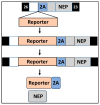Recombinant Influenza A Viruses Expressing Reporter Genes from the Viral NS Segment
- PMID: 39408912
- PMCID: PMC11476892
- DOI: 10.3390/ijms251910584
Recombinant Influenza A Viruses Expressing Reporter Genes from the Viral NS Segment
Abstract
Studying influenza A viruses (IAVs) requires secondary experimental procedures to detect the presence of the virus in infected cells or animals. The ability to generate recombinant (r)IAV using reverse genetics techniques has allowed investigators to generate viruses expressing foreign genes, including fluorescent and luciferase proteins. These rIAVs expressing reporter genes have allowed for easily tracking viral infections in cultured cells and animal models of infection without the need for secondary approaches, representing an excellent option to study different aspects in the biology of IAV where expression of reporter genes can be used as a readout of viral replication and spread. Likewise, these reporter-expressing rIAVs provide an excellent opportunity for the rapid identification and characterization of prophylactic and/or therapeutic approaches. To date, rIAV expressing reporter genes from different viral segments have been described in the literature. Among those, rIAV expressing reporter genes from the viral NS segment have been shown to represent an excellent option to track IAV infection in vitro and in vivo, eliminating the need for secondary approaches to identify the presence of the virus. Here, we summarize the status on rIAV expressing traceable reporter genes from the viral NS segment and their applications for in vitro and in vivo influenza research.
Keywords: NS segment; fluorescence; luminescence; plasmid-based reverse genetics; recombinant influenza A virus; replication-competent reporter-expressing influenza A virus; reporter genes.
Conflict of interest statement
The authors declare no conflicts of interest.
Figures






Similar articles
-
Bioluminescent reporter influenza A viruses to track viral infections.bioRxiv [Preprint]. 2025 Jul 15:2025.07.15.664884. doi: 10.1101/2025.07.15.664884. bioRxiv. 2025. PMID: 40791423 Free PMC article. Preprint.
-
Novel replication-competent reporter-expressing Rift Valley fever viruses for molecular studies.J Virol. 2025 Jan 31;99(1):e0178224. doi: 10.1128/jvi.01782-24. Epub 2024 Dec 12. J Virol. 2025. PMID: 39665546 Free PMC article.
-
Rapid reconstruction of infectious bronchitis virus expressing fluorescent protein from its nsp2 gene based on transformation-associated recombination platform.J Virol. 2025 Jul 22;99(7):e0053525. doi: 10.1128/jvi.00535-25. Epub 2025 Jun 5. J Virol. 2025. PMID: 40470960 Free PMC article.
-
Physical interventions to interrupt or reduce the spread of respiratory viruses.Cochrane Database Syst Rev. 2023 Jan 30;1(1):CD006207. doi: 10.1002/14651858.CD006207.pub6. Cochrane Database Syst Rev. 2023. PMID: 36715243 Free PMC article.
-
Host-Specific and Segment-Specific Evolutionary Dynamics of Avian and Human Influenza A Viruses: A Systematic Review.PLoS One. 2016 Jan 13;11(1):e0147021. doi: 10.1371/journal.pone.0147021. eCollection 2016. PLoS One. 2016. PMID: 26760775 Free PMC article.
Cited by
-
Evaluating Probenecid or Oseltamivir Inhibition of Influenza A Virus Replication Through Plaque Assay or Fluorescent Focus Assay Using Non-Structural Protein 1-H1N1 Venus Reporter Virus.Viruses. 2025 Feb 27;17(3):335. doi: 10.3390/v17030335. Viruses. 2025. PMID: 40143264 Free PMC article.
References
Publication types
MeSH terms
Substances
Grants and funding
LinkOut - more resources
Full Text Sources
Miscellaneous

